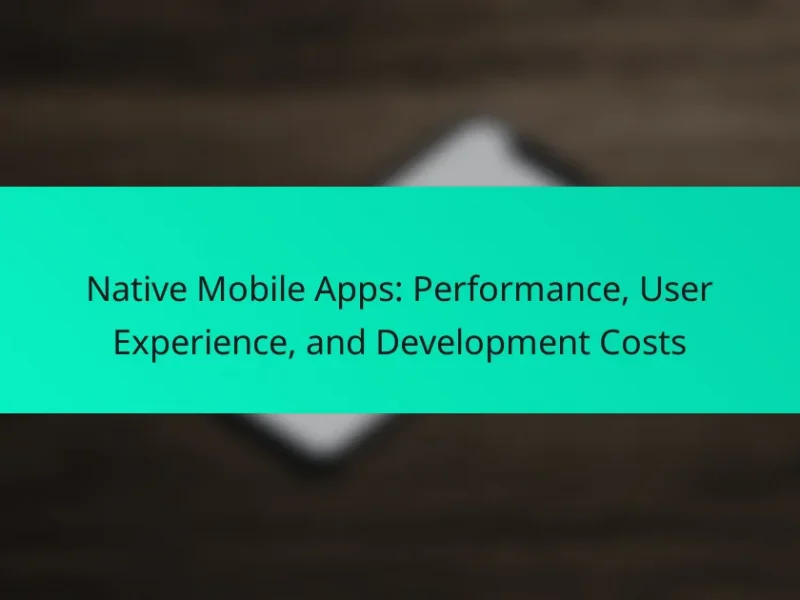Mobile app monetization strategies are essential methods for generating revenue from mobile applications, including in-app purchases, subscription models, advertising, and freemium models. Best practices for effective monetization involve selecting the appropriate model, optimizing user experience, and utilizing data analytics to identify trends. Successful examples of monetization can be seen in companies like Spotify, Clash of Clans, and WhatsApp, each employing unique strategies to achieve significant revenue growth. This article provides a detailed overview of these monetization strategies, best practices, and notable success stories in the mobile app industry.

What are Mobile App Monetization Strategies?
Mobile app monetization strategies are methods used to generate revenue from mobile applications. Common strategies include in-app purchases, subscription models, advertising, and freemium models. In-app purchases allow users to buy virtual goods or features within the app. Subscription models charge users a recurring fee for access to premium content or services. Advertising involves displaying ads within the app to earn revenue based on impressions or clicks. Freemium models offer a free version of the app with limited features, encouraging users to upgrade for additional benefits. According to Statista, mobile app revenue reached over $580 billion in 2020, highlighting the effectiveness of these strategies.
How do Mobile App Monetization Strategies impact app developers?
Mobile app monetization strategies significantly impact app developers by determining their revenue potential. Developers choose from various models, such as in-app purchases, subscriptions, and ad-based monetization. Each model influences user engagement and retention differently. For instance, in-app purchases can lead to higher immediate revenue but may deter some users. Subscriptions provide a steady income stream, encouraging long-term user relationships. Ad-based monetization can generate passive income but may affect user experience negatively. According to Statista, mobile app revenue is projected to reach $407.31 billion by 2026, highlighting the importance of effective monetization strategies for developers. Thus, the choice of monetization strategy directly affects a developer’s financial success and user satisfaction.
What challenges do developers face when implementing these strategies?
Developers face several challenges when implementing mobile app monetization strategies. One significant challenge is user acquisition. Attracting users to download and engage with the app can be costly and time-consuming. Another challenge is balancing monetization with user experience. Aggressive monetization tactics can lead to user dissatisfaction and increased churn rates. Additionally, developers often struggle with choosing the right monetization model. Each model, whether in-app purchases or ads, has its own set of complexities and impacts on revenue.
Technical integration is also a challenge, as developers must ensure that monetization features work seamlessly within the app. Moreover, market competition can hinder the effectiveness of monetization strategies. With numerous apps available, standing out and capturing user attention is increasingly difficult. Finally, tracking and analyzing user behavior to optimize monetization strategies requires robust analytics tools and expertise. These challenges highlight the complexities developers must navigate to successfully monetize their mobile applications.
How do user preferences influence monetization choices?
User preferences significantly influence monetization choices in mobile apps. Developers analyze user behavior and feedback to determine preferred payment models. For instance, users may favor subscription models for continuous access to content. In contrast, others might prefer one-time purchases for specific features or content. Understanding these preferences helps developers tailor their monetization strategies effectively. According to a study by App Annie, 70% of users prefer free apps with optional in-app purchases. This data illustrates that user preference for free access can drive the adoption of freemium models. Ultimately, aligning monetization strategies with user preferences can enhance user satisfaction and retention.
What are the primary models of Mobile App Monetization?
The primary models of mobile app monetization include in-app purchases, subscription services, advertising, and paid apps. In-app purchases allow users to buy virtual goods or features within the app. Subscription services charge users a recurring fee for access to premium content or features. Advertising generates revenue by displaying ads to users, often through pay-per-click or impressions. Paid apps require users to purchase the app upfront before downloading. According to Statista, in-app purchases accounted for over 50% of global app revenue in 2021, highlighting their effectiveness in monetization strategies.
What are the differences between freemium and premium models?
Freemium and premium models differ primarily in access and payment structure. Freemium models offer basic features for free, enticing users to upgrade for advanced functionalities. This approach often relies on a large user base to convert a small percentage into paying customers. In contrast, premium models require upfront payment for full access to the app’s features. Users pay before experiencing the service, which can lead to fewer overall users but higher revenue per user. Studies show that freemium apps can generate significant revenue through in-app purchases, while premium apps often rely on direct sales for income.
How do in-app purchases work in mobile apps?
In-app purchases are transactions made within mobile applications to buy additional content or features. Users can access a range of digital goods, such as virtual currency, premium features, or subscription services. Payment is processed through the app store’s billing system, ensuring security and convenience. Most apps offer a variety of purchase options, including one-time payments and recurring subscriptions. The app developer sets the prices and can adjust them based on demand. In 2021, in-app purchases accounted for over 50% of global app revenue, highlighting their importance in monetization strategies. This model allows developers to offer free versions of apps while generating revenue from users who choose to enhance their experience.
What role do advertisements play in monetization strategies?
Advertisements serve as a primary revenue source in monetization strategies for mobile apps. They enable app developers to generate income without charging users directly. Advertisements can take various forms, including banners, interstitials, and rewarded videos. Each format offers different user engagement levels and revenue potential. For instance, rewarded video ads often lead to higher user retention and engagement. According to eMarketer, mobile ad spending is projected to reach $200 billion by 2024. This statistic underscores the significant financial impact of integrating advertisements into app monetization. By leveraging advertisements, apps can remain free for users while still achieving profitability.

What are the Best Practices for Mobile App Monetization?
The best practices for mobile app monetization include selecting the right monetization model, optimizing user experience, and leveraging data analytics. Choosing a model such as freemium, subscription, or in-app purchases aligns with user expectations. A seamless user experience retains users and maximizes revenue potential. Regularly analyzing user data helps identify trends and preferences, allowing for targeted improvements. Implementing A/B testing can refine monetization strategies effectively. Additionally, maintaining transparency in in-app purchases builds user trust. According to a report by App Annie, apps that employ multiple monetization strategies often see higher revenue growth.
How can developers choose the right monetization model for their app?
Developers can choose the right monetization model for their app by assessing their target audience and app purpose. Understanding user demographics and preferences is crucial. For instance, a gaming app may benefit from in-app purchases, while a utility app might be better suited for a subscription model.
Analyzing competitors can provide insights into successful monetization strategies. Developers should also consider the app’s engagement level. High engagement apps often thrive on ad revenue.
Testing different models through A/B testing can help identify the most effective approach. According to a study by Statista, 53% of mobile app revenue comes from in-app purchases, highlighting its effectiveness.
Ultimately, aligning the monetization strategy with user expectations and app functionality will lead to better outcomes.
What factors should be considered when selecting a monetization strategy?
When selecting a monetization strategy, several factors must be considered. The target audience significantly influences the choice of strategy. Understanding user preferences and behaviors can guide decision-making. Market trends also play a critical role. Analyzing competitors’ strategies can provide valuable insights. Revenue potential is another crucial factor. Estimating potential earnings helps in evaluating different models. User experience must not be overlooked. A strategy should enhance user satisfaction and retention. Lastly, scalability is important. The chosen model should support growth as the app evolves.
How can user feedback inform monetization decisions?
User feedback can significantly inform monetization decisions by providing insights into user preferences and behaviors. Developers can analyze feedback to identify which features users value most. This understanding can guide the selection of monetization models, such as in-app purchases or subscription services. For instance, if users express a desire for premium features, a subscription model may be more appealing. Additionally, feedback can reveal pain points related to pricing or ads, allowing developers to adjust strategies accordingly. A study by Apptentive found that 77% of users are more likely to pay for an app that incorporates their feedback. This demonstrates the direct link between user input and successful monetization strategies.
What are common pitfalls to avoid in Mobile App Monetization?
Common pitfalls to avoid in mobile app monetization include overloading users with ads. Excessive advertising can lead to user frustration and app abandonment. Another pitfall is failing to understand the target audience. Misalignment with user preferences can result in low engagement. Additionally, neglecting user feedback can hinder app improvement. Ignoring analytics can prevent data-driven decisions. Underestimating the importance of app store optimization can limit visibility. Lastly, not testing monetization strategies can lead to ineffective revenue models. These factors collectively impact the app’s financial success and user retention.
How can excessive ads affect user retention?
Excessive ads can negatively impact user retention by creating a frustrating experience. Users may feel overwhelmed by frequent interruptions during app usage. This frustration can lead to decreased satisfaction with the app. Research shows that 70% of users uninstall apps due to ad overload. Excessive ads can also distract users from the app’s primary functions. This distraction diminishes the overall value users derive from the app. Consequently, users are more likely to seek alternatives that provide a better experience. Thus, a balance in ad frequency is crucial for maintaining user engagement and retention.
What mistakes lead to poor monetization outcomes?
Common mistakes that lead to poor monetization outcomes include inadequate market research and failure to understand user preferences. Many developers skip thorough analysis of their target audience. This oversight results in misaligned monetization strategies. Another mistake is neglecting user experience in favor of aggressive monetization tactics. Research shows that intrusive ads can drive users away, harming long-term revenue. Additionally, not diversifying revenue streams limits potential income. Relying solely on one model, like in-app purchases, can be risky. Failing to track and analyze performance metrics can lead to missed opportunities for optimization. A study by App Annie indicates that apps with consistent updates and improvements see better monetization outcomes.

What are some Success Stories in Mobile App Monetization?
Successful mobile app monetization stories include those of companies like Spotify, Clash of Clans, and WhatsApp. Spotify utilizes a freemium model, attracting millions of users with free access and converting a significant percentage to premium subscriptions. Clash of Clans generated over $1 billion in revenue within its first year through in-app purchases and engaging gameplay. WhatsApp initially offered free service, later monetizing through business accounts, showcasing a unique approach to user acquisition and retention. These examples highlight effective strategies in the mobile app monetization landscape.
What apps have successfully implemented innovative monetization strategies?
TikTok has successfully implemented innovative monetization strategies. The app utilizes a combination of in-app purchases, advertising, and brand partnerships. TikTok’s ad revenue model includes various formats such as in-feed ads and branded challenges. In 2022, TikTok generated over $11 billion in ad revenue. Another example is Fortnite, which employs a free-to-play model with in-game purchases for cosmetic items. Fortnite reportedly earned over $9 billion in its first two years. Additionally, Spotify has adopted a freemium model, offering both free and premium subscription tiers. In 2022, Spotify reported over 400 million active users, with a significant portion converting to paid subscriptions. These examples illustrate how apps can leverage diverse monetization strategies to achieve substantial financial success.
How did these apps adapt their strategies over time?
Apps adapted their strategies over time by incorporating user feedback and data analytics. They shifted from one-time purchase models to freemium and subscription-based models. This change was driven by the need for continuous revenue streams. Many apps introduced in-app purchases to enhance user experience and engagement. They also focused on personalized marketing tactics to retain users. Regular updates and feature enhancements were implemented to keep the user base engaged. The rise of social media integration allowed apps to leverage user-generated content for marketing. Data-driven decision-making became central to refining monetization strategies.
What lessons can be learned from their success?
Successful mobile app monetization strategies teach several key lessons. First, understanding the target audience is crucial for tailoring monetization models. Apps that successfully engage users often utilize a mix of in-app purchases and advertisements. This approach maximizes revenue while maintaining user satisfaction.
Additionally, continuous user feedback helps refine the monetization strategy. Apps that adapt based on user behavior tend to retain more users and increase profitability. Implementing analytics tools is essential for tracking performance and making data-driven decisions.
Moreover, offering value through premium features can enhance user loyalty. Successful apps often provide a free version to attract users while reserving advanced features for paying customers. This freemium model has proven effective in driving conversions.
Finally, building a strong brand and community around the app fosters long-term success. Engaged users are more likely to recommend the app and contribute to its growth. These lessons highlight the importance of a user-centered approach in mobile app monetization.
What metrics should be tracked to measure monetization success?
Key metrics to track for monetization success include Average Revenue Per User (ARPU), Customer Lifetime Value (CLV), and Conversion Rate. ARPU measures the revenue generated per user over a specific period. This metric helps in understanding the effectiveness of monetization strategies. CLV estimates the total revenue a business can expect from a single customer account. It is crucial for assessing long-term profitability. Conversion Rate tracks the percentage of users who complete a desired action, such as making a purchase. A higher conversion rate indicates effective monetization efforts. Additionally, tracking Monthly Recurring Revenue (MRR) and Churn Rate provides insights into revenue stability and user retention. MRR represents predictable revenue streams, while Churn Rate indicates the percentage of users who stop using the app. Monitoring these metrics allows businesses to make data-driven decisions and optimize their monetization strategies effectively.
How can developers analyze user engagement to improve monetization?
Developers can analyze user engagement by tracking metrics such as session length, frequency of use, and user retention rates. These metrics provide insights into how users interact with the app. For instance, higher session lengths may indicate greater user interest. Analyzing user retention helps identify which features keep users coming back.
Developers can utilize tools like Google Analytics or Firebase to collect engagement data. These platforms offer detailed reports on user behavior patterns. By segmenting users based on engagement levels, developers can tailor monetization strategies.
For example, they may introduce targeted in-app purchases for highly engaged users. A study by App Annie found that apps with personalized experiences see a 20% increase in revenue. This data supports the importance of analyzing user engagement to enhance monetization strategies effectively.
What tools are available for tracking monetization performance?
Tools for tracking monetization performance include Google Analytics, Adjust, and App Annie. Google Analytics provides insights into user behavior and revenue generation. Adjust specializes in mobile attribution and analytics, helping optimize ad spend. App Annie offers market data and app performance metrics. These tools enable app developers to measure key performance indicators effectively. They help identify trends and optimize monetization strategies. Using these tools can lead to improved revenue outcomes.
What tips can enhance Mobile App Monetization efforts?
To enhance mobile app monetization efforts, focus on user engagement and retention. Engaging users increases the likelihood of in-app purchases and ad interactions. Implement personalized experiences to cater to user preferences. This can lead to higher conversion rates. Optimize your app’s user interface for seamless navigation. A smooth experience encourages users to spend more time in the app. Utilize data analytics to understand user behavior. This insight can help tailor monetization strategies effectively. Consider multiple revenue streams, such as subscriptions and ads. Diversifying income sources can stabilize revenue. Lastly, continuously test and iterate on monetization strategies. Frequent adjustments based on user feedback can enhance overall performance.
Mobile app monetization strategies are essential methods for generating revenue from applications, including in-app purchases, subscriptions, advertising, and freemium models. This article explores how these strategies impact app developers, the challenges they face during implementation, and the influence of user preferences on monetization choices. It also examines the primary models of monetization, differences between freemium and premium approaches, and best practices for optimizing revenue. Additionally, the article highlights successful case studies and metrics for measuring monetization success, providing valuable insights for developers aiming to enhance their mobile app profitability.


